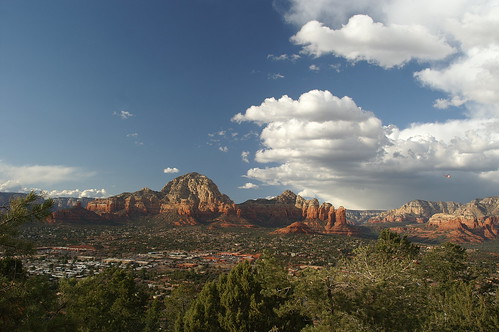
My first visit to Sedona was in June 1999, when Bryan and I stopped in between Flagstaff and Phoenix. We were in Arizona for the first wedding among our college friends, just 13 months after graduation, and decided to make a brief vacation out of it. We landed in Phoenix on a Wednesday, drove to Flagstaff, toured the Grand Canyon on Thursday, then stopped by Sedona on Friday on our way back to Phoenix. We slid at Slide Rock in the morning -- the sun hot, the water frigid -- bounced up into the red rock hills on a jeep tour (not a pink one) in the afternoon and sped south on I-17, arriving back in Phoenix for dinner and to meet up with the rest of our friends arriving at Sky Harbor Airport.
The Sedona I remembered based on that brief visit was a quaint mountain town rimmed by the picturesque vermillion cliffs, an artsy community with galleries and boutiques along Main Street -- not its real name -- overlaid on an outdoorsy, mountain hamlet inhabited by hikers and fat-tire enthusiasts, the crunchy granola set. So either Sedona has changed a bit in the last 11 years, or my brief glimpse kept me away from the reality. The 2010 Sedona I saw was closer to Orlando than Boulder, the town I've since learned fits my memory of Sedona much more than actual Sedona does now.
Casey and I stayed in the western end of town, along Arizona 89A after it bears right once you leave downtown as you're traveling from the north. The highway out by our hotel is nothing like the two-lane center of town; outside the shopping district it becomes the strip-mall district, a four-lane thoroughfare lined with chain stores and restaurants with a few touches of local flavor to provide some variety. I had no idea this end of town existed, so when Casey was scouting hotels, I encouraged the affordable and let her research the options. I figured the west end was an extension of downtown, that the Days Inn would be nestled in with other budget lodgings yet still maintaining Northern Arizona charm. Sedona had come highly recommended to Casey by some friends, and I paired those recommendations with my memories. It occurs to me now that maybe those friends hold different opinions on what makes for a quiet, enjoyable vacation spot.
After checking in, we drove downtown and walked both sides of the main street, ducking into a few shops when the window displays -- or the varietys of jerky -- drew our attention. During our stroll, though, we stumbled into the hidden Sedona, the part that I hadn't seen before and that erased much of the charm for me. After turning down the first time-share hawker who addressed us ("Hi, you folks just get into town?" was enough of a warning), I was fooled by the next guy. He was nice enough, and I don't remember exactly what he said that caused us to detour into the alcove and stand at his desk while he pulled various brochures tried to sell us on a 90-minute time-share presentation the next morning in exchange for discounted jeep tour tickets, a free romantic candlelight dinner or a great deal on a scenic train ride in the mountains near Jerome. He had an answer for every activity we threw at him in an attempt to end the spiel, asking only that we show up at the resort south of town at 8:30 the next morning. By 10, we'd be free to begin our excursions, but with a free two-night stay at one of their 170 worldwide resorts for our time. We turned out to be one tough sell, and he finally gave up when we convinced him that, in fact, yes, we are the kind of people who enjoy waking up in the morning, taking our time over breakfast gauging the weather and our gut feelings before deciding where the day will take us.
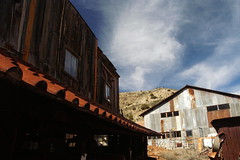 Saturday did take us to Jerome, but I don't recall any train tracks or engine whistles. We wouldn't have considered watching the mountains from inside a passenger compartment, nor on a bench of the open-air cars. I may hop aboard the railroad at Disney World to see the park or get from Frontierland to Toontown, but on my one visit to Jerome, I'd prefer to get closer to the sights. So we began by driving straight through town to the "ghost town" at the old Gold King Mine. It's a ghost town in the same way that the Olive Garden is authentic Italian food -- because they say it is and they charge you for it. And while it may be a ghost town out of a Scooby Doo episode, where it takes an active imagination to see the thrill in it, we were OK with that. Mostly an assortment of rusting cars and trucks, some mining equipment and a collection of shacks and buildings that once may have been used for blacksmithing, wood cutting and other old-timey pursuits, it is at least set up around the long-closed entrances to the mine. We enjoyed our hour perambulating over the hills among the Studebakers and farm animals -- two penned-in goats, a flock of chickens and roosters scurrying about, a donkey that knew to ring its bell in hopes of food and a gray bunny that had dug itself a nice little trench in the dirt beneath a plow. It all began with a pleasant welcome from the in-character "miner" who bore a striking resemblance to Frank the Tank's boy, Blue, and who, when told we hailed from New Jersey, replied, "I've heard of that place. You don't live in Camden, do you? Or Newark or Paterson?" While we're close to Paterson, we assured him our neighorhood is far from the mean streets.
Saturday did take us to Jerome, but I don't recall any train tracks or engine whistles. We wouldn't have considered watching the mountains from inside a passenger compartment, nor on a bench of the open-air cars. I may hop aboard the railroad at Disney World to see the park or get from Frontierland to Toontown, but on my one visit to Jerome, I'd prefer to get closer to the sights. So we began by driving straight through town to the "ghost town" at the old Gold King Mine. It's a ghost town in the same way that the Olive Garden is authentic Italian food -- because they say it is and they charge you for it. And while it may be a ghost town out of a Scooby Doo episode, where it takes an active imagination to see the thrill in it, we were OK with that. Mostly an assortment of rusting cars and trucks, some mining equipment and a collection of shacks and buildings that once may have been used for blacksmithing, wood cutting and other old-timey pursuits, it is at least set up around the long-closed entrances to the mine. We enjoyed our hour perambulating over the hills among the Studebakers and farm animals -- two penned-in goats, a flock of chickens and roosters scurrying about, a donkey that knew to ring its bell in hopes of food and a gray bunny that had dug itself a nice little trench in the dirt beneath a plow. It all began with a pleasant welcome from the in-character "miner" who bore a striking resemblance to Frank the Tank's boy, Blue, and who, when told we hailed from New Jersey, replied, "I've heard of that place. You don't live in Camden, do you? Or Newark or Paterson?" While we're close to Paterson, we assured him our neighorhood is far from the mean streets.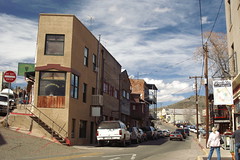 We returned to downtown Jerome for lunch, eating what may be the best nachos I've ever tasted at Quince (the pulled pork put them over the top) and pausing at various historical markers on the buildings -- or what was left of them. Jerome is what I thought Sedona was, a tourist destination of shops, galleries, museums and eateries, but without the trap-like commercialism of chain resorts or golfing vacations. Many of the original buildings from the boomtown days have been renovated and re-opened as similar businesses -- the brothel as bar -- while others stand as a literal shell of their former selves, a plaque and a photograph provided to give us a glimpse at the glory days.
We returned to downtown Jerome for lunch, eating what may be the best nachos I've ever tasted at Quince (the pulled pork put them over the top) and pausing at various historical markers on the buildings -- or what was left of them. Jerome is what I thought Sedona was, a tourist destination of shops, galleries, museums and eateries, but without the trap-like commercialism of chain resorts or golfing vacations. Many of the original buildings from the boomtown days have been renovated and re-opened as similar businesses -- the brothel as bar -- while others stand as a literal shell of their former selves, a plaque and a photograph provided to give us a glimpse at the glory days.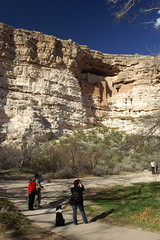 Once descending Cleopatra Hill, we doubled back beyond Sedona for a quick visit to Montezuma Castle National Monument, a Native American cliff dwelling carved into the limestone along Beaver Creek. It was a short visit that allowed me to add a stamp to my National Parks Passport and made the purchase of an annual pass worthwhile -- the $5 per person put us at $55 for the trip (Grand Canyon will be $25, Canyonlands and Arches $10 each), so $80 for admission to the National Parks System over the next 364 days seemed like a wise financial choice. It's a well-designed program -- the back of the card holds lines for two signatures, so Casey and I each signed it, allowing either of us to use it for admission to any of the parks, monuments or landmarks under NPS jurisdiction. And for areas like Montezuma's Castle, where admission is per person rather than per car (and for seven days at that), the pass covers the bearer and up to three guests. The ranger explained a local benefit of the pass, which doubles as a Red Rock Pass for hiking in and around Sedona. We used it after leaving Montezuma, driving up to the airport for an aerial view from Overlook Point. Saved another $5 there, putting us at 20 bucks before it's all gravy until March 5, 2011.
Once descending Cleopatra Hill, we doubled back beyond Sedona for a quick visit to Montezuma Castle National Monument, a Native American cliff dwelling carved into the limestone along Beaver Creek. It was a short visit that allowed me to add a stamp to my National Parks Passport and made the purchase of an annual pass worthwhile -- the $5 per person put us at $55 for the trip (Grand Canyon will be $25, Canyonlands and Arches $10 each), so $80 for admission to the National Parks System over the next 364 days seemed like a wise financial choice. It's a well-designed program -- the back of the card holds lines for two signatures, so Casey and I each signed it, allowing either of us to use it for admission to any of the parks, monuments or landmarks under NPS jurisdiction. And for areas like Montezuma's Castle, where admission is per person rather than per car (and for seven days at that), the pass covers the bearer and up to three guests. The ranger explained a local benefit of the pass, which doubles as a Red Rock Pass for hiking in and around Sedona. We used it after leaving Montezuma, driving up to the airport for an aerial view from Overlook Point. Saved another $5 there, putting us at 20 bucks before it's all gravy until March 5, 2011.Dinner that night was at the Oak Creek Brewery, where we walked in to find two seats at the bar and the Gold Lager to our liking before calling it a night. With snow in the forecast for the next day, I wanted to make sure we had enough time to get to the Grand Canyon well before nightfall.
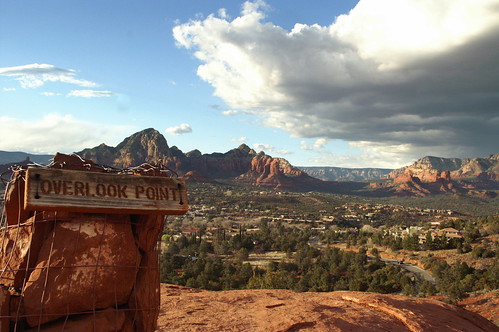
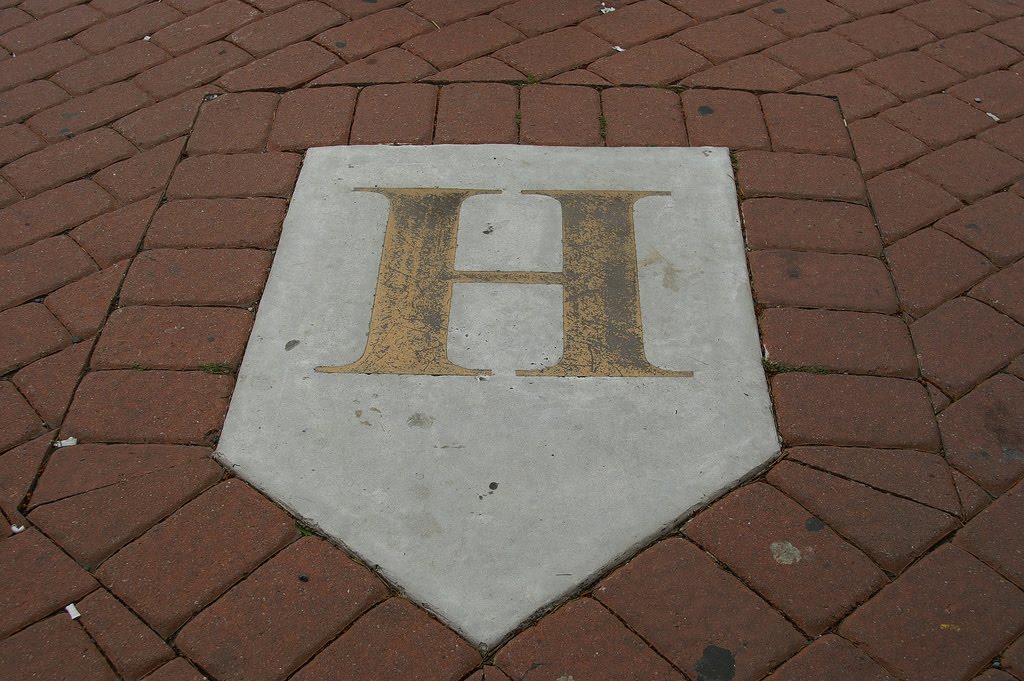
No comments:
Post a Comment